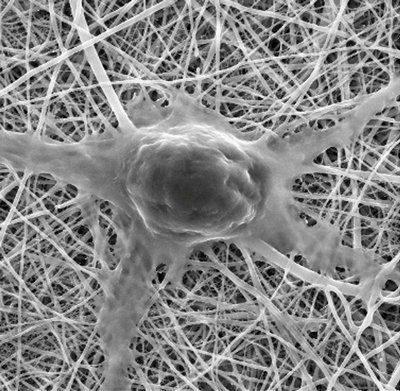June 16, 2009
Crustacean shell with polyester creates mixed-fiber material for nerve repair
In the clothing industry it’s common to mix natural and synthetic fibers. Take cotton and add polyester to make clothing that’s soft, breathable and wrinkle free.
Now researchers at the University of Washington are using the same principle for biomedical applications. Mixing chitosan, found in the shells of crabs and shrimp, with an industrial polyester creates a promising new material for the tiny tubes that support repair of a severed nerve, and could serve other medical uses. The hybrid fiber combines the biologically favorable qualities of the natural material with the mechanical strength of the synthetic polymer.
“A nerve guide requires very strict conditions. It needs to be biocompatible, stable in solution, resistant to collapse and also pliable, so that surgeons can suture it to the nerve,” said Miqin Zhang, a UW professor of material science and engineering and lead author of a paper now available online in the journal Advanced Materials. “This turns out to be very difficult.”
After an injury that severs a peripheral nerve, such as one in a finger, nerve endings continue to grow. But to regain control of the nerve surgeons must join the two fragments. For large gaps surgeons used to attempt a more difficult nerve graft. Current surgical practice is to attach tiny tubes, called nerve guides, that channel the two fragments toward each other.
Today’s commercial nerve guides are made from collagen, a structural protein derived from animal cells. But collagen is expensive, the protein tends to trigger an immune response and the material is weak in wet environments, such as those inside the body.
The strength of the nerve guide is important for budding nerve cells.
“This conduit serves as a guide to protect the neuron from injury,” Zhang said. “If the tube is made of collagen, it’s difficult to keep the conduit open because any stress and it’s going to collapse.”
Zhang and colleagues developed an alternative. The first component of their material, polycaprolactone, is a strong, flexible, biodegradable polyester commonly used in sutures. It is not suitable on its own for use as a nerve guide because water-based cells don’t like to grow on the polyester’s water-repelling surface.
The second component, chitosan, is found in the shells of crustaceans. It’s cheap, readily available, biodegradable and biocompatible, meaning that it won’t trigger an immune response. Chitosan has a rough surface similar to the surfaces found inside the body that cells can attach to. The problem is chitosan swells in water, making it weak in wet environments.
Researchers combined the fibers at the nanometer scale by first using a technique called electrospinning to draw the materials into nanometer-scale fibers, and then weaving the fibers together. The resulting material has a texture similar to that of the nanosized fibers of the connective tissue that surrrounds human cells.
The two materials are different and are difficult to blend, but proper mixing is crucial because imperfectly blended fibers have weak points.
Zhang and colleagues built prototype nerve guides measuring 1.5 millimeters (0.06 inches) in diameter, and between five and 15 centimeters (two to six inches) long. They tested a guide made from the chitosan-polyester blend against another biomaterial under study, polylacticcoglycolic acid, and a commercially available collagen guide.
Of the three materials, the chitosan-polyester weave showed the most consistent performance for strength, flexibility and resistance to compression under both dry and wet conditions. Under wet conditions, which the researchers say best mimics those in the body, the chitosan-polyester blend required twice as much force to push the tube halfway shut as the other biomaterial, and eight times as much force as the collagen tube.
The new material showed promise for nerve guides but would also work well for wound dressings, heart grafts, tendons, ligament, cartilage, muscle repair and other biomedical applications, Zhang said.
The research was funded by the National Science Foundation through a grant to the UW’s Engineered Biomaterials Research Center. Co-authors on the paper are Richard Ellenbogen, Narayan Bhattarai, Zhensheng Li, Jonathan Gunn, Matthew Leung, Ashleigh Cooper, Dennis Edmonson and Omid Veiseh of the UW; Ming-Hong Chen of the National Yang-Ming University in Taiwan; and Yong Zhang of the National University of Singapore.
###
For more information, contact Zhang at 206-616-9356 or mzhang@u.washington.edu.


